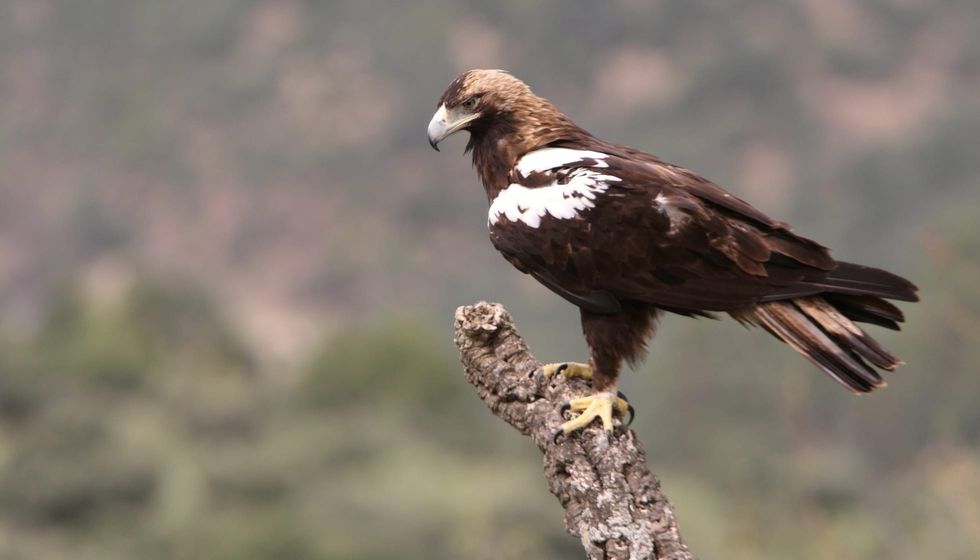A cousin of the eastern imperial eagle, the Spanish imperial eagle (Aquila adalberti) is a threatened species of eagle endemic to the Iberian Peninsula. This species is also known as the Iberian imperial eagle and Adalbert's eagle.
Due to their predatory nature, these birds are often referred to as raptors or birds of prey. Earlier, the Iberian imperial eagle was considered as a subspecies of the eastern imperial eagle, but due to the differences in ecology and morphology, this species is identified as a separate species.
Adult eagles possess blackish-brown colored plumage and resemble the eastern imperial eagle and golden eagle, while young ones have a pale sandy colored plumage. The average weight and length of this species are around 5.5-10.6 lb (2.5-4.8 kg) and 29-33 in (74-85 cm), respectively. These large birds have a wingspan of 5.8-7.2 ft (177-220 cm).
The species inhabits several countries of Europe such as Spain, Portugal, and Morocco, and sometimes in the Netherlands. This species is found in the Mediterranean forests and marshes of the Donana National Park. Spanish imperial eagles also dwell in the Dehesa woodlands of central and Southwest Spain. One can also spot them in agricultural fields.
The International Union for Conservation of Nature classified the species as Vulnerable as the population is declining constantly due to loss of habitat, human encroachment, illegal poisoning, and electrocution.
Let's read more interesting facts about the Spanish imperial eagle and if you find this article interesting, don't forget to check out our exciting articles about different animals like the tawny eagle and the crowned eagle.
Spanish Imperial Eagle Interesting Facts
What type of animal is a Spanish imperial eagle?
The Spanish imperial eagle (Aquila adalberti) is a threatened species of eagle native to the Iberian Peninsula. These birds are known as raptors or birds of prey. The Spanish imperial eagle feeds on rabbits, rodents, and pigeons.
What class of animal does a Spanish imperial eagle belong to?
Spanish imperial eagles belong to the class of Aves, the family of Accipitridae, and the Aquila genus. Earlier, the Iberian imperial eagle was considered as a subspecies of the eastern imperial eagle, but due to the differences in ecology and morphology, this species is identified as a separate species.
How many Spanish imperial eagles are there in the world?
The population of Spanish imperial eagles has been affected severely by threats like loss of habitat, illegal poisoning, human encroachment, and electrocution. In the '60s, there were only 30 pairs of Spanish imperial eagles in Spain with the population increasing to 35 pairs in 1994.
With the help of conservation efforts, the global population increased to 324 pairs, 318 pairs alone in Spain.
Where does a Spanish imperial eagle live?
The Spanish imperial eagle (Aquila adalberti) species is mainly found in central and southwest Spain. A handful of the population is also found in other countries of Europe such as Portugal and Morocco. The species has also appeared in the Netherlands once.
What is a Spanish imperial eagle's habitat?
While talking about the Spanish imperial eagle habitat, this bird is found in isolated trees of the Mediterranean forests and marshes of the Donana National Park. Spanish imperial eagles also dwell in the Dehesa woodlands of central and southwest Spain. One can also spot them in agricultural fields.
Who do Spanish imperial eagles live with?
Very little information regarding Spanish imperial eagle behavior is available, but the bird is solitary and prefers to live alone. The bird is sedentary and generally lives in its territory throughout the year. The species can also be found in loose flocks during exploratory and long-distance flights. Pairs can also be found during the reproduction season.
How long does a Spanish imperial eagle live?
The average lifespan of a Spanish eagle is around 16.4 years, but the bird can live up to 40 years in captivity. Species such as the eastern imperial eagle can live for around 56 years.
How do they reproduce?
The Spanish imperial eagle (Aquila adalberti) follows the monogamy reproduction system which means pairs stay together for life. Adults generally turn sexually mature after four years of age, if an individual dies, the other would find a new partner. The breeding season is not known, but these birds generally construct nests from February to April.
Nests are constructed on trees in dry and mature woodlands. Females generally lay about two to three eggs in each season. Both parents incubate the eggs and it usually lasts for around 40-43 days.
Mortality in the nest is mainly caused by human disturbance and predation. Studies also reveal that the older and stronger sibling generally kills the younger one. Young ones primarily live for around 63-70 days, but some are reluctant to leave even after several months.
What is their conservation status?
The International Union for Conservation of Nature classified the species as Vulnerable as the population is declining constantly due to loss of habitat, human encroachment, illegal poisoning, and electrocution. The decline in the population of rabbits due to diseases such as myxomatosis and rabbit hemorrhage might have caused a reduction in the numbers of Spanish imperial eagles.
Spanish Imperial Eagle Fun Facts
What do Spanish imperial eagles look like?
These large raptors have blackish-brown colored plumage and tawny-colored nape and crown. They also have a white band on their shoulders and wings. Unlike adults, young ones have a pale sandy-colored plumage and broad black bands on the upper and lower sides of the wings. In this picture, one can notice a juvenile in flight.

*Please note that this is an image of a Steppe eagle, not a Spanish Imperial Eagle specifically. If you have an image of a Spanish Imperial Eagle, then please let us know at hello@kidadl.com.
How cute are they?
The Spanish imperial eagle is one of the most magnificent birds. These big raptors are best known for their predatory skills, for their hunting and flying remarkably fast. Also, one can learn several lessons from these birds such as they love storms, thus one shall always embrace new challenges in life.
How do they communicate?
Like other species, Adalbert's eagle uses similar methods to communicate with each other. The species use several high-pitched chirps and whistles to communicate. During the breeding season, males and females perform several courtship displays in the air. Also, tactile, visual, and chemical cues are used while communicating.
How big is a Spanish imperial eagle?
The average weight and length of this species are around 5.5-10.6 lb (2.5-4.8 kg) and 29-33 in (74-85 cm), respectively. Also, the wingspan length is around 5.8-7.2 ft (177-220 cm). This species is bigger than the sea eagle and the golden eagle.
How fast can a Spanish imperial eagle fly?
The Spanish imperial eagle speed is not known as of now, but the bird is known as the free-flying apex predator. The imperial eagle can travel for more than 4971 mi (8000 km) in just six months. Between seven to 15 months of age, the juvenile eagle starts to travel long distances.
How much does a Spanish imperial eagle weigh?
The species weighs around 5.5-10.6 lb (2.5-4.8 kg).
What are the male and female names of the species?
There are no specific names given to male and female Spanish imperial eagles.
What would you call a baby Spanish imperial eagle?
Terms such as eaglet and juveniles are used to refer to the baby Spanish imperial eagle.
What do they eat?
Spanish imperial eagles are carnivores and often prey on rodents such as mice, pigeons, and reptiles like snakes. These eagles are also known as rabbit-favoring birds.
Are they dangerous?
Eagles are considered dangerous birds. These apex predators are known for hunting and killing their prey within seconds. With their sharp, strong bills and claws, they are able to kill big mammals such as red foxes. The attack of these birds on humans could prove very fatal.
Would they make a good pet?
As the species is Endangered, it is not legal to keep the Spanish imperial eagle as a pet. Along with other threats, humans have equally contributed to the exploitation of the species. Also, the bird is quite hard to tame and unpredictable. Instead of capturing the bird, people should protect this splendid species.
Did you know...
The Philippine eagle is considered the largest eagle in the world.
Why is the Spanish imperial eagle Endangered?
There are several factors that have made the species Endangered and rare. These factors are loss of habitat, human encroachment, illegal poisoning, and electrocution. The decline in the population of their prey rabbits due to diseases such as myxomatosis and rabbit hemorrhage might have caused a reduction in the numbers of Spanish imperial eagles.
In the '60s, the species was classified as Critically Endangered, but as governments and different organizations have taken conservation efforts, the improvement in the numbers is visible.
Spanish imperial eagle vs. eastern imperial eagle
Earlier, the Iberian imperial eagle was considered as a subspecies of the eastern imperial eagle but due to the differences in ecology and morphology, the species is identified as a separate species.
The plumage, nape, and crown look almost similar in both species, but the eastern imperial eagles are smaller than Spanish imperial eagles. The former species possess smaller hallux claws that help to differentiate from others.
Here at Kidadl, we have carefully created lots of interesting family-friendly animal facts for everyone to discover! Learn more about some other birds from our martial eagle facts and bateleur eagle facts for kids pages.
You can even occupy yourself at home by coloring in one of our free printable Spanish imperial eagle coloring pages.










